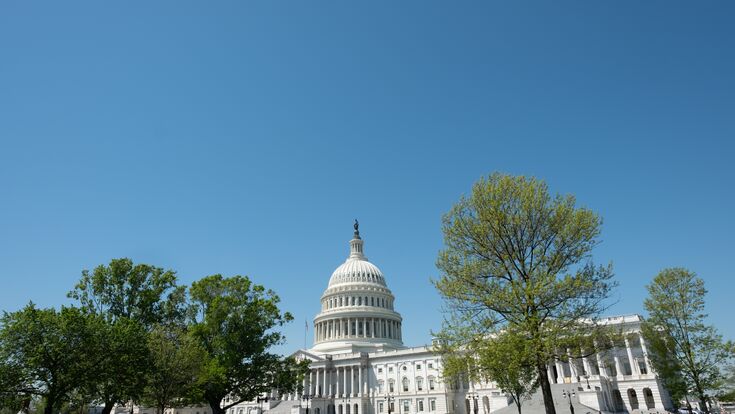US bipartisan bills : New recycling and composting legislation promotes sustainability

US lawmakers have taken the next step to more sustainability in waste management. Last month the Senate passed two pieces of bipartisan legislation focused on improving the recycling and composting systems.
The Recycling and Composting Accountability Act (RCAA) would strengthen data collection on US recycling systems and explore the potential for a national composting strategy. This legislation would require the Environmental Protection Agency (EPA) to collect and publish data on recycling and composting rates nationwide to provide an accurate picture of performance both at national and state levels. According to the bill's sponsors, this information is critical to the improvement of existing recycling and composting programs and the evaluation of future recycling policies.
Conversely, the Recycling Infrastructure and Accessibility Act (RIAA) would establish a pilot recycling programme at EPA. On a competitive basis, this programme would grant funds to eligible entities to improve recycling accessibility in a community or communities within the same geographic area. The purpose of the programme is to fund eligible projects that would substantially increase access to recycling systems in underserved communities through the use of a hub-and-spoke model for recycling infrastructure development.
“Most Americans want to do their part to reduce waste and harmful pollution,” US Senator Tom Carper, Chairman of the Senate Environment and Public Works (EPW) Committee and co-chair of the Senate Recycling Caucus. “Yet, roughly two-thirds of recyclable materials still aren’t being recycled, resulting in more and more waste polluting our land, air and oceans. These two bipartisan bills will help address several challenges plaguing our nation’s recycling and composting systems — including reliable data collection and improving access to recycling programs."
Industry stakeholders reacted positively to the Senate's passage of the legislation.
“We need to recycle more, period, and these bipartisan bills will help us achieve that goal. Improving the country’s recycling infrastructure is paramount to increasing our recycling rates for all materials and ensures we keep waste in the circular economy and out of landfills," said the Plastics Industry Association. The U.S. Composting Council (USCC) stated: “In order to grow composting infrastructure in the US we need to know what the metrics are on current facility capacities and throughput. There’s a need to have state data uniformly reported annually at the same time and then aggregated. This would give us a better picture of where to concentrate funding and deliver a better return on public and private investments."
The House of Representatives needs to pass this legislation as a next step.
Andrew Cassilly, Vice President of Governmental Relations for Bioenergy Devco, a leader in anaerobic digester development and operation in Europe and the United States, talks to WMW about the impact of this new legislation on the waste management industry, the necessity of a national strategy and how composting and anaerobic digestion complement each other.
What impact will the RCAA and the RIAA have on the waste management industry?
The Recycling and Composting Accountability Act (RCAA) and the Recycling Infrastructure and Accessibility Act (RIAA) are set to significantly influence the waste management industry in the U.S. The RCAA's emphasis on data collection, infrastructure assessment, and best practices establishment is poised to enhance transparency and efficiency in recycling and composting systems nationwide. By providing comprehensive data on recycling programs, contamination rates, and market evaluation, it can inform targeted interventions to boost recycling rates and infrastructure. Meanwhile, the RIAA's pilot program focuses on improving recycling accessibility, particularly in underserved communities, through grants for infrastructure enhancements. By addressing disparities in recycling services and fostering public-private partnerships, the RIAA aims to drive innovation and investment in recycling infrastructure, ultimately promoting more equitable and sustainable waste management practices. Together, these acts signal a commitment to advancing recycling infrastructure and accessibility, likely leading to positive impacts on efficiency, equity, and sustainability in the waste management industry.

How much organic waste ends up in municipal solid waste and in landfills in the US?
In the United States, a substantial amount of organic waste, especially food waste, ends up in municipal solid waste and eventually in landfills. According to the EPA, food waste accounts for 24 per cent of municipal solid waste, amounting to over 63 million tons in 2018.
What's the environmental impact of organic waste in landfills?
Landfills pose significant environmental concerns, particularly due to the release of methane gas during organic decomposition. Methane is a potent greenhouse gas, 84 times more effective at trapping heat than carbon dioxide, exacerbating climate change. Additionally, landfills emit carbon dioxide, water vapour, and other gasses that contribute to climate change and smog formation. Despite federal regulations requiring liners at landfills, leaks are common, leading to leachate contamination of nearby water sources, posing risks to ecosystems. And, leachate, containing high levels of ammonia and toxins like mercury, can lead to eutrophication and dead zones in water bodies, further harming aquatic life.
What are the advantages of a separate biowaste collection?
There are multiple advantages to diverting organics from the waste stream and many are often overlooked. Most of us go right to the environmental benefits of organics recycling such as those mentioned. While there are several environmental benefits there are also economic and social benefits as well. Diverting organics transforms an environmental liability into an economic opportunity and a slew of new industries. Reducing organic contamination will have a dramatic improvement on recycling rates of paper, plastic, and other materials currently landfilled due to contamination. Landfill life expectancy is dramatically increased, saving taxpayer dollars. The compost and soil amendments can be sold as a valuable organic fertilizer promoting soil health. Restaurants and other food service establishments could see savings on reduced trash collection and insurance claims for employees injured while heaving heavy bags of food waste into the dumpster. There are several social benefits as well. We all know the overwhelming odour of a dumpster filled with rotting food waste. Separating and containing for frequent removal will not only address the odours but cut down on a food source for rats and other disease-carrying pests. Those who benefit the most from this movement will be the members of disadvantaged communities who are statistically found to live near and work in the waste processing industry.
Related article: Why - and how - biowaste should be collected separately
Diverting organics transforms an environmental liability into an economic opportunity and a slew of new industries.Andrew Cassilly
Why is a national composting strategy necessary and how soon do you think could one be implemented?
In the absence of federal guidance, organics diversion efforts will develop as a patchwork of many states implementing their own, sometimes conflicting solutions. The development of a national strategy will provide a comprehensive data-driven outline to the states on best practices for organics diversion. Our success in diverting 100% of organic materials from the waste stream will rely on a variety of technologies and processes. I am confident this effort will demonstrate the need for a partnership of composting, anaerobic digestion, and other associated industries to achieve this goal. Fortunately, many states currently collect the data needed by the EPA so the development of the strategy could potentially be completed within two years.
What should be the key points of such a strategy?
- Collecting the environmental, health, and fiscal data from states to determine and demonstrate the true impacts of organic recycling in those areas. This information will be key to motivating states to adopt new practices as they see the cost of their delay.
- Identifying existing successful programs as a framework of potential solutions for the states. These may look different from region to region such as rural areas that produce agricultural waste.
- Our existing waste infrastructure is not designed for separating food waste. Maryland Law requires new schools to be designed and built with this infrastructure in their cafeterias. This is critical for training the next generation. Expanding this requirement to all food service facilities such as military bases, colleges, and fast-food restaurants will allow for the effective collection of organics.
- Maryland Law codifies the term “organics recycling” to be inclusive of composting, anaerobic digestion, and any other technology to process this waste. A comprehensive strategy should include all technologies to achieve our goal of 100% organics diversion from our waste stream.
How can composting and anaerobic digestion complement each other?
Composting and anaerobic digestion offer distinct benefits for organic waste management, and when used together, they can create a powerful solution. Anaerobic digestion efficiently processes a wide range of organic waste that can be challenging to compost, producing biogas for energy and nutrient-rich digestate for use as a soil amendment. Composting, on the other hand, converts organic waste into stable compost, improving soil health and promoting plant growth. By combining these processes, more organic waste can be diverted from landfills, renewable energy can be generated, and valuable nutrients can be recovered. Anaerobic digestion can also help reduce the volume of organic waste before composting, increasing efficiency and minimizing residual waste. This synergy between anaerobic digestion and composting represents a significant step towards a sustainable and circular economy, where organic waste is seen as a valuable resource.
Related article: Biogas: An important contribution to climate and resource protection
Composting and anaerobic digestion offer distinct benefits for organic waste management, and when used together, they can create a powerful solution.Andrew Cassilly
What are the main benefits of anaerobic digestion as a waste management technique?
Anaerobic digestion offers several key benefits as a waste management technique. This technology efficiently converts organic waste into renewable energy and nutrients, namely biogas and digestate. This process can operate on a small footprint allowing these facilities to be built in urban areas reducing transportation impacts while processing a large volume of waste. Biogas can displace fossil fuels for heating and power generation, reducing greenhouse gas emissions. The resulting digestate serves as an organic fertilizer, closing the loop in the food cycle and enhancing soil health. Anaerobic digestion operates in a closed system, minimizing odours and methane emissions, and embodies principles of the circular economy by maximizing resource recovery from food waste.
How does anaerobic digestion compare to other waste treatment methods in terms of environmental impact and energy recovery
Anaerobic digestion is the preferred method for sustainable food waste management, due to its significant environmental benefits and energy recovery potential. Unlike incineration, which can impose energy burdens and produce harmful emissions, anaerobic digestion breaks down organic materials in an oxygen-free environment, generating biogas—a valuable source of renewable energy. At COP28 in December of 2023, the EPA endorsed anaerobic digestion as a key tool for organics recycling, signifying its importance in reducing greenhouse gas emissions and advancing environmental sustainability efforts. The EPA has emphasized the importance of avoiding landfills due to their substantial negative environmental impact.
How do you see the future market for AD in the US?
Looking ahead to 2024 and beyond, I anticipate a surge in focus and investment towards proven food waste technologies such as anaerobic digestion (AD), in conjunction with advancements in tracking software, recycling, upcycling solutions, and consumer-facing technology. Favourable regulatory shifts, including renewable energy targets and subsidies for AD facilities, are encouraging local governments to seek sustainable alternatives to landfilling. Private sector innovation is also on the rise, with companies specializing in organics recycling partnering with communities to build advanced AD infrastructure. With smarter technologies deployed at scale, the ambitious goal of halving food waste by 2030 becomes increasingly attainable.
Related article: Biomethane: On the road away from fossil fuels


